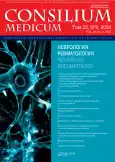Головная боль напряжения: клиника, диагностика, лечение
- Авторы: Котова О.В.1, Беляев А.А.2, Акарачкова Е.С.1
-
Учреждения:
- Международное общество «Стресс под контролем»
- ГБУЗ «Научно-исследовательский институт скорой помощи им. Н.В. Склифосовского» Департамента здравоохранения г. Москвы
- Выпуск: Том 22, № 9 (2020)
- Страницы: 68-70
- Раздел: Статьи
- URL: https://journals.rcsi.science/2075-1753/article/view/95376
- DOI: https://doi.org/10.26442/20751753.2020.9.200458
- ID: 95376
Цитировать
Полный текст
Аннотация
Ключевые слова
Полный текст
Открыть статью на сайте журналаОб авторах
Ольга Владимировна Котова
Международное общество «Стресс под контролем»
Email: ol_kotova@mail.ru
канд. мед. наук, невролог, вице-президент Москва, Россия
Антон Андреевич Беляев
ГБУЗ «Научно-исследовательский институт скорой помощи им. Н.В. Склифосовского» Департамента здравоохранения г. Москвымл. науч. сотр. Москва, Россия
Елена Сергеевна Акарачкова
Международное общество «Стресс под контролем»д-р мед. наук, врач-невролог, президент Международного общества «Стресс под контролем» Москва, Россия
Список литературы
- Stovener LJ, Hagen K, Jensen R et al. The global burden of headache: a documentation of headache prevalence and disability worldwide. Cephalalgia 2007; 27: 193-210.
- Laurell K, Larsson B, Eeg-Olofsson O. Prevalence of headache in Swedish schoolchildren, with a focus on tension-type headache. Cephalalgia 2004; 24: 380-8.
- Schwartz BS, Stewart WF, Simon D, Lipton RB. Epidemiology of tension-type headache. JAMA 1998; 279: 381-3.
- Scher AI, Stewart WF, Liberman J, Lipton RB. Prevalence of frequent headache in a population sample. Headache 1998; 38: 497-506.
- Schwartz BS, Stewart WF, Lipton RB. Lost workdays and decreased work effectiveness associated with headache in the workplace. J Occup Environ Med 1997; 39: 320-7.
- Headache Classification Committee of the International Headache Society (IHS). The International Classification of Headache Disorders, 3rd ed. (beta version). Cephalalgia 2013; 33: 629.
- Rasmussen BK, Jensen R, Schroll M, Olesen J. Epidemiology of headache in a general population - a prevalence study. J Clin Epidemiol 1991; 44: 1147.
- Jensen R, Rasmussen BK, Pedersen B, Olesen J. Muscle tenderness and pressure pain thresholds in headache. A population study. Pain 1993; 52: 193.
- Jensen R, Fuglsang-Frederiksen A. Quantitative surface EMG of pericranial muscles. Relation to age and sex in a general population. Electroencephalogr Clin Neurophysiol 1994; 93: 175.
- Russell MB, Saltyte-Benth J, Levi N. Are infrequent episodic, frequent episodic and chronic tension-type headache inherited? J Headache Pain 2006; 7: 119-26.
- Jensen R. Peripheral and central mechanisms in tension-type headache: an update. Cephalalgia 2003; 23 (Suppl. 1): 49.
- Ashina S, Bendtsen L, Ashina M. Pathophysiology of tension-type headache. Curr Pain Headache Rep 2005; 9: 415-22.
- Ashina M. Neurobiology of chronic tension-type headache. Cephalalgia 2004; 24: 161-72.
- Bendtsen L, Schoenen J. Synthesis of tension-type headache mechanisms. In: Olesen J, Goadsby PJ, Ramadan N et al. (Eds.) The Headaches. Philadelphia: Lippincott Williams & Wilkins, 2005; p. 677-81.
- Holroyd KA, Stensland M, Lipchik GL, Hill KR et al. Psychosocial correlates and impact of chronic tension-type headaches. Headache 2000; 40: 3-16.
- Артеменко А.Р., Осипова В.В., Филатова Е.Г. и др. Первичные головные боли хронического течения (диагностика, клиника, терапия). Методические рекомендации №26, Правительство Москвы, Департамент здравоохранения г. Москвы, 2014. [Artemenko A.R., Osipova V.V., Filatova E.G. et al. Pervichnye golovnye boli khronicheskogo techeniia (diagnostika, klinika, terapiia). Metodicheskie rekomendatsii no. 26, Pravitel'stvo Moskvy, departament zdravookhraneniia g. Moskvy, 2014 (in Russian).]
- Dodick D, Freitag F. Evidence-based understanding of medication-overuse headache: clinical implications. Headache 2006; 46 (Suppl. 4): S202-11.
- Ryan RE. Motrin - a new agent for the symptomatic treatment of muscle contraction headache. Headache 1977; 16: 280-83.
- Diamond S. Ibuprofen versus aspirin and placebo in the treatment of muscle contraction headache. Headache 1983; 23: 206-10.
- Schachtel BP, Furey SA, Thoden WR. Nonprescription ibuprofen and acetaminophen in the treatment of tension-type headache. J Clin Pharmacol 1996; 36: 1120-5.
- Nebe J, Heier M, Diener HC. Low-dose ibuprofen in self-medication of mild to moderate headache: a comparison with acetylsalicylic acid and placebo. Cephalalgia 1995; 15: 531-5.
- Moore RA, Derry S, Straube S et al. Faster, higher, stronger? Evidence for formulation and efficacy for ibuprofen in acute pain. Pain 2014; 155 (1): 14-21.
- Packman B, Packman E, Doyle G. et al. Solubilized ibuprofen: evaluation of onset, relief, and safety of a novel formulation in the treatment of episodic tension-type headache. Headache 2000; 40: 561-7.
- Bendtsen L, Evers S, Linde M et al. EFNS guideline on the treatment of tension-type headache - report of an EFNS task force. Eur J Neurol 2010; 17: 1318.
- Steiner TJ, Lange R, Voelker M. Aspirin in episodic tension-type headache: placebo-controlled dose-ranging comparison with paracetamol. Cephalalgia 2003; 23: 59-66.
- Diener HC, Pfaffenrath V, Pageler L et al. The fixed combination of acetylsalicylic acid, paracetamol and caffeine is more effective than single substances and dual combination for the treatment of headache: a multicentre, randomized, doubleblind, single-dose, placebo-controlled parallel group study. Cephalalgia 2005; 25: 776-87.
- Diamond S, Freitag FG. The use of ibuprofen plus caffeine to treat tension-type headache. Curr Pain Headache Rep 2001; 5: 472-8.
- Scher AI, Stewart WF, Ricci JA, Lipton RB. Factors associated with the onset and remission of chronic daily headache in a population-based study. Pain 2003; 106: 81-9.
- Bendtsen L, Jensen R. Amitriptyline reduces myofascial tenderness in patients with chronic tension-type headache. Cephalalgia 2000; 20: 603-10.
- Bendtsen L. Central and peripheral sensitization in tension-type headache. Curr Pain Headache Rep 2003; 7 (6): 460-5.
- Bettucci D, Testa L, Calzoni S et al. Combination of tizanidine and amitriptyline in the prophylaxis of chronic tension-type headache: evaluation of efficacy and impact on quality of life. J Headache Pain 2006; 7: 34-6.
- Scripter C. Headache: Tension-Type Headache. FP Essent 2018; 473: 17-20.
- Stetter F, Kupper S. Autogenic training: a meta-analysis of clinical outcome studies. Appl Psychophysiol Biofeedback 2002; 27 (1): 45-98.
- Fernandez-de-Las-Penas C, Alonso-Blanco C, Cuadrado ML et al. Are manual therapies effective in reducing pain from tension-type headache? A systematic review. Clin J Pain 2006; 22: 278-85.
- Lyngberg AC, Rasmussen BK, Jorgensen T, Jensen R. Prognosis of migraine and tension-type headache: a populationbased follow-up study. Neurology 2005; 65: 580-5.
Дополнительные файлы





